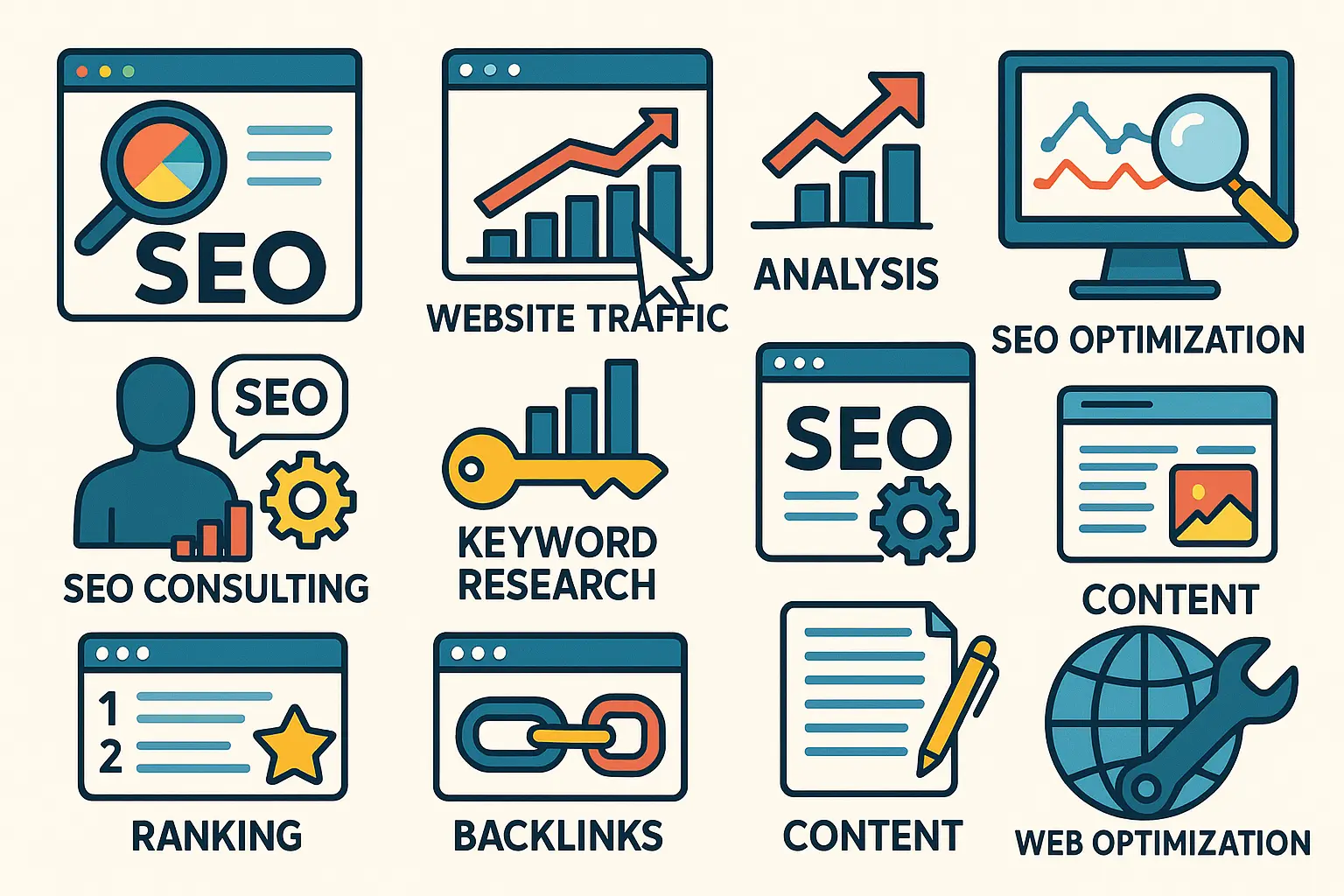Introduction to Modern SEO
Search Engine Optimization (SEO) is far from dead in 2025. In fact, it has become even more important in today’s fast-moving digital world. Modern SEO isn’t just about keywords anymore. Instead, it focuses on creating clear, useful content that meets what users want.
The goal of SEO is still the same: to get more visibility and bring in organic traffic. However, the methods we use have changed. To succeed, you must stay updated with new trends and changes in search engine algorithms. Businesses that do this are more likely to grow online.
The Impact of AI on Content Creation
Artificial Intelligence (AI) has changed how we create and improve content. AI tools can help with many tasks. For example, they can suggest keywords, build outlines, and even write first drafts. This makes it easier and faster to create content.
Even so, AI is not perfect. While it helps with speed, it can’t always match the depth or emotion of human writing. Because of this, it’s important to edit AI-generated content carefully. Add your own insights, check for errors, and make the content more engaging.
Google focuses on quality. It uses E-E-A-T (Experience, Expertise, Authority, Trustworthiness) to judge content. So, your content should not only be accurate but also helpful and trustworthy. AI can assist, but human input makes it better.
Google’s Search Generative Experience
Google’s new Search Generative Experience (SGE) is changing how people search. It gives quick, clear answers without needing users to click through many sites. This is helpful for users but can reduce web traffic to some pages.
Still, this shift brings chances for smart marketers. When your content ranks high, it may be featured in SGE answers. To get there, aim for featured snippets. Write short, direct answers to common questions. Use headings, bullet points, and structured data.
In addition, keep content updated. Google rewards fresh, relevant information. If your site provides the best answers, SGE can actually boost your visibility.
Digital Marketing Strategies
Today, SEO works best as part of a full digital marketing plan. That means combining SEO with social media, email marketing, and content marketing. When these work together, your online presence gets stronger.
Understanding your audience is key. What are they looking for? What problems do they want to solve? Answering these questions helps you make better content. Keyword research is part of this, but knowing search intent matters just as much.
Also, always review what’s working and what isn’t. A flexible, well-planned strategy will help you stay competitive and reach your business goals.
Content Strategy and Planning
Good content starts with a solid plan. Begin with keyword research. Then, group topics together. This helps you cover subjects fully and tells search engines what your site is about.
Next, think about your audience. What questions do they have? What terms do they use? Create content that is helpful, clear, and easy to understand. Also, vary your formats. Use blog posts, videos, images, and FAQs.
You should also reuse your content smartly. For instance, turn a blog into a video, podcast, or infographic. This boosts your content’s reach and gives you better results.
High-Quality Content Creation
Creating great content is essential for SEO. High-quality content keeps people on your site, answers their questions, and builds trust.
To achieve this, keep it simple. Use short sentences and clear words. Structure your writing with headings, lists, and white space. This makes it easier to read.
Engage your readers. Ask questions, offer solutions, and include strong calls to action. Over time, valuable content helps your brand grow and increases your visibility.
Leveraging AI Tools for SEO
AI tools make SEO easier and more efficient. They help with keyword research, content suggestions, and technical audits. This saves time and improves results.
For example, tools like SEMrush and Clearscope show which keywords to use and how to improve your writing. They also analyze what your competitors are doing.
However, don’t rely only on tools. Use your judgment to decide what fits your audience. Combine AI insights with human creativity for the best outcome.
Building High-Quality Backlinks
Backlinks are still a strong factor in search rankings. But not all links are equal. A few high-quality backlinks are better than many low-quality ones.
To earn good links, you need strong content. Write original guides, do research, or offer unique insights. Then, reach out to websites and ask them to link to your content.
Try methods like guest blogging or broken link building. Make sure your content adds real value. When others link to your site, you gain trust and visibility.
Navigating Constant Algorithm Updates
Google and other search engines update their algorithms all the time. Some updates are small. Others are big and can impact your site traffic.
Because of this, stay informed. Follow SEO blogs, join online groups, and watch your site’s analytics. This helps you spot changes early.
Most of all, focus on what matters. Fast loading times, mobile-friendliness, and helpful content will always be important. These basics help protect your rankings over time.
The Role of Content Marketing in SEO
Content marketing and SEO work well together. Content attracts users. SEO makes it easy for them to find.
A good content plan includes different formats. Write blog posts, create videos, and share infographics. Each type supports the others.
Focus on quality and user intent. When content meets users’ needs, they stay longer and are more likely to convert. Keep publishing regularly. This keeps your site active and helps your rankings.
Understanding User Behavior and Intent
To create effective content, you must know your audience. What do they want? What are they really asking when they search?
Use analytics tools to learn more. Look at which pages get the most views, how long people stay, and where they click. Also, study keywords. Do they show that users want to learn, compare, or buy?
When you understand behavior and intent, you can write better content. This brings more visitors and keeps them coming back.
Visual and Voice Search Optimization
More people use voice assistants and visual tools to search. So, it’s important to adapt.
For voice search, write in a natural tone. Use common questions and clear answers. Add FAQ sections to your pages. Also, focus on local keywords. Many voice searches are location-based.
For visual search, make sure your images are clear and relevant. Use descriptive file names and alt text. Also, optimize videos with transcripts and captions.
These steps help you reach new users and improve your overall SEO.
Brand Building and SEO
Building a brand supports your SEO goals. A strong brand builds trust, and trust helps your rankings.
When people know your name, they search for it. These branded searches show Google that your site is credible. Positive reviews and online mentions also help.
To build a brand, be consistent. Use the same voice and message across your website, social media, and emails. Share your story and values. Over time, this builds loyalty and boosts your search presence.
Measuring SEO Success
To know if your SEO is working, track your progress. Use key performance indicators (KPIs) like organic traffic, page views, bounce rate, and keyword rankings.
Set clear goals. Then, check your results with tools like Google Analytics and Search Console. Look for trends and changes over time.
Use this data to improve. If a page isn’t working, revise it. If traffic drops, review recent changes. A data-driven approach leads to smarter decisions and better results.
The Future of SEO
SEO is not dying. It’s changing. Trends like AI, voice search, and visual search are shaping the future. To succeed, stay open to learning and adapting.
Invest in tools and training. Focus on your users. Make your content helpful and your website fast and easy to use.
The best SEO strategy is one that puts people first. When you earn their trust, search engines take notice too.
SEO Opportunities and Challenges
SEO brings great opportunities. You can reach more people, grow your audience, and boost your sales. But it also brings challenges.
You’ll face competition, updates, and changing rules. That’s why flexibility matters. Be ready to change your approach when needed.
Keep testing. Keep learning. And keep focusing on your users. When you do, you’ll be ready for whatever comes next in the world of SEO.



